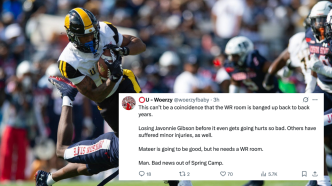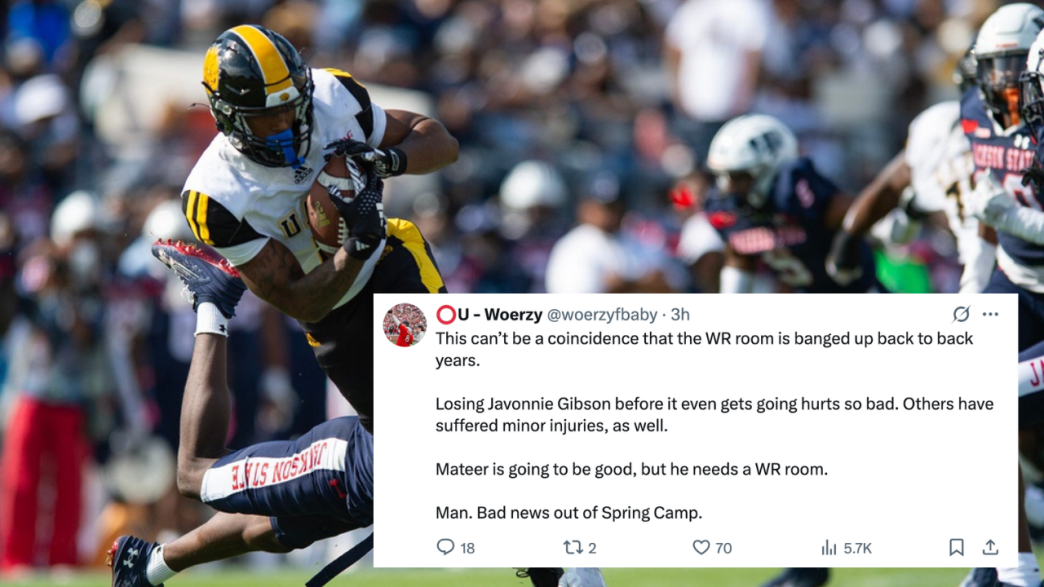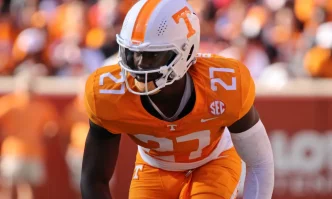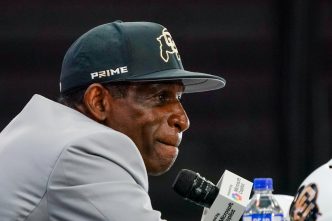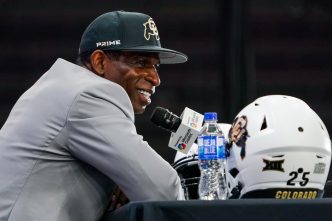Last year, the Sooners’ wide receiver room was hit hard by injuries, with key players like Nic Anderson, Jalil Farooq, Andrel Anthony, Jayden Gibson, and Deion Burks all missing significant time. Anderson, the team’s leading returning receiver from 2023, played just nine snaps in 2024 before a quad injury sidelined him, while Farooq broke his foot in the season opener. Anthony, recovering from a 2023 ACL tear, played only eight snaps, and Jayden Gibson missed the entire season with a knee injury sustained in fall camp. Burks, a transfer from Purdue, managed to lead the team with 31 catches but was limited to five games due to a thigh injury and later a concussion. Collectively, these five receivers—who had combined for 171 receptions, 2,925 yards, and 25 touchdowns in 2023—managed just 28 catches for 252 yards in 2024. The depth was so depleted that the team resorted to converting a freshman defensive back to receiver mid-season, a move that underscored the severity of the crisis.
The recurring injuries have not gone unnoticed by Oklahoma’s passionate fanbase. Posts on X reflect growing frustration with the program’s medical staff, with some fans directly calling for changes. One user, posting in December 2024, expressed dissatisfaction with the medical staff, suggesting that their handling of injuries might be a reason for losing key returning wide receivers to the transfer portal. Another user, commenting on the situation in April 2025, went as far as to say they would stop donating to the program until “shit is fixed,” questioning the credentials of the sports medicine department and pointing out the absurdity of having “7+ WRs out before Aug 1st.” These sentiments highlight a broader concern among fans that the medical staff may be failing to adequately prevent or manage injuries, particularly at the wide receiver position.
Potential Issues with the Medical and Training Staff
Several factors could be contributing to the Sooners’ injury woes, and the medical and training staff’s practices are at the center of the debate. One possible issue is the team’s injury prevention and rehabilitation protocols. Wide receivers, who often engage in high-speed sprints, sudden cuts, and physical contested catches, are inherently prone to injuries like hamstring strains, quad tears, and knee issues. However, the sheer volume of injuries at Oklahoma—particularly soft-tissue injuries like Anderson’s quad tear and Burks’ thigh contusion—suggests that the team’s conditioning and recovery programs may not be adequately addressing these risks. For example, Anderson’s quad injury was described by head coach Brent Venables as a “significant tear” that nearly required surgery, with recovery timelines extending up to three months. Such injuries can often be mitigated through proper warm-up routines, strength training, and load management, raising questions about whether the staff is implementing best practices.
Another concern is the rehabilitation process. Farooq’s foot injury, which required surgery, saw a setback during his recovery, delaying his return beyond the initial six-to-eight-week timeline. Similarly, Jayden Gibson’s knee injury in 2024 and his reported “small setback” during limited non-contact work in spring 2025 suggest that the rehab process may not be effectively preparing players to return to full activity. Posts on X have speculated that the medical staff’s approach might be contributing to these setbacks, with one user in April 2025 suggesting that the staff’s failure to adapt could be why players like Farooq, Anderson, and others transferred out after the 2024 season.
The team’s training regimen during spring practice could also be a factor. Spring camp is a critical time for installing new systems and building chemistry, as evidenced by quarterback John Mateer working with Gibson and Burks during the offseason to adapt to offensive coordinator Ben Arbuckle’s new system. However, the intensity of these practices may be putting undue strain on players, especially those like Gibson who are coming off a high-workload season at the FCS level. The Sooners’ wide receiver room, already thin after losing several players to the transfer portal, cannot afford to push its players beyond their physical limits, yet the back-to-back years of spring injuries suggest that the staff may not be striking the right balance between preparation and player safety.
Broader Implications for the Program
The recurring injuries have significant implications for Oklahoma as they head into their second year in the SEC, a conference known for its physicality and depth. The Sooners’ offense struggled mightily in 2024, finishing with a 6-7 record in their SEC debut, largely due to the lack of production in the passing game. With Gibson now sidelined, the team’s hopes of revitalizing their offense in 2025 are in jeopardy. Mateer, a transfer from Washington State who led the FBS in total touchdowns in 2024, will need reliable targets to execute Arbuckle’s system, but the current state of the wide receiver room makes that a tall order. Young players like Meteer, Ivan Carreon, and Zion Kearney will need to step up, but as the X post notes, they need a healthy supporting cast to thrive.
Beyond the on-field impact, the injury crisis could affect recruiting and player retention. Oklahoma has historically been a destination for top wide receiver talent, but the program’s inability to keep its players healthy may deter future prospects. The transfer portal has already taken a toll, with players like Anderson, Farooq, and Anthony leaving after the 2024 season, possibly due to frustration with their injury-plagued tenures. If the medical staff’s issues persist, Oklahoma risks losing more talent, further depleting an already thin position group.
A Call for Change
The Oklahoma Sooners’ wide receiver injuries are more than just bad luck—they point to a deeper issue within the program’s medical and training infrastructure. While injuries are an inherent part of football, the frequency and severity of the Sooners’ wide receiver injuries over the past two years suggest that the current approach is not working. The medical staff must reevaluate its injury prevention strategies, from conditioning programs to load management, to ensure that players are not being overworked during spring camp. Additionally, the rehabilitation process needs to be more effective in getting players back to full strength without risking setbacks, as seen with Farooq and Jayden Gibson.
Head coach Brent Venables, who has already made significant changes to the offensive staff by bringing in Arbuckle, may need to consider a similar overhaul of the medical and training staff. The program’s leadership should also investigate whether the sports medicine department has the resources and expertise needed to handle the demands of SEC football. As one X user pointed out, the credentials of the medical staff are under scrutiny, and fans are demanding accountability.
For now, Oklahoma fans can only hope that the remaining wide receivers stay healthy and that players like Meteer can rise to the occasion. But until the program addresses the root causes of its injury problems, the Sooners’ wide receiver room—and the team’s broader aspirations—will remain at risk. The 2025 season is a critical one for Oklahoma, and the health of its players will be the difference between a return to championship contention and another year of disappointment.

